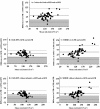Determination of the best method to estimate glomerular filtration rate from serum creatinine in adult patients with sickle cell disease: a prospective observational cohort study
- PMID: 22866669
- PMCID: PMC3465224
- DOI: 10.1186/1471-2369-13-83
Determination of the best method to estimate glomerular filtration rate from serum creatinine in adult patients with sickle cell disease: a prospective observational cohort study
Abstract
Background: Sickle cell disease (SCD) leads to tissue hypoxia resulting in chronic organ dysfunction including SCD associated nephropathy. The goal of our study was to determine the best equation to estimate glomerular filtration rate (GFR) in SCD adult patients.
Methods: We conducted a prospective observational cohort study. Since 2007, all adult SCD patients in steady state, followed in two medical departments, have had their GFR measured using iohexol plasma clearance (gold standard). The Cockcroft-Gault, MDRD-v4, CKP-EPI and finally, MDRD and CKD-EPI equations without adjustment for ethnicity were tested to estimate GFR from serum creatinine. Estimated GFRs were compared to measured GFRs according to the graphical Bland and Altman method.
Results: Sixty-four SCD patients (16 men, median age 27.5 years [range 18.0-67.5], 41 with SS-genotype were studied. They were Sub-Saharan Africa and French West Indies natives and predominantly lean (median body mass index: 22 kg/m2 [16-33]). Hyperfiltration (defined as measured GFR >110 mL/min/1.73 m2) was detected in 53.1% of patients. Urinary albumin/creatinine ratio was higher in patients with hyperfiltration than in patients with normal GFR (4.05 mg/mmol [0.14-60] versus 0.4 mg/mmol [0.7-81], p = 0.01). The CKD-EPI equation without adjustment for ethnicity had both the lowest bias and the greatest precision. Differences between estimated GFRs using the CKP-EPI equation and measured GFRs decreased with increasing GFR values, whereas it increased with the Cockcroft-Gault and MDRD-v4 equations.
Conclusions: We confirm that SCD patients have a high rate of glomerular hyperfiltration, which is frequently associated with microalbuminuria or macroalbuminuria. In non-Afro-American SCD patients, the best method for estimating GFR from serum creatinine is the CKD-EPI equation without adjustment for ethnicity. This equation is particularly accurate to estimate high GFR values, including glomerular hyperfiltration, and thus should be recommended to screen SCD adult patients at high risk for SCD nephropathy.
Figures


References
-
- Guasch A, Navarrete J, Nass K, Zayas CF. Glomerular involvement in adults with sickle cell hemoglobinopathies. Prevalence and clinical correlates of progressive renal failure. J Am Soc Nephro. 2000;7:1261–1263. - PubMed
Publication types
MeSH terms
Substances
LinkOut - more resources
Full Text Sources
Other Literature Sources
Medical

